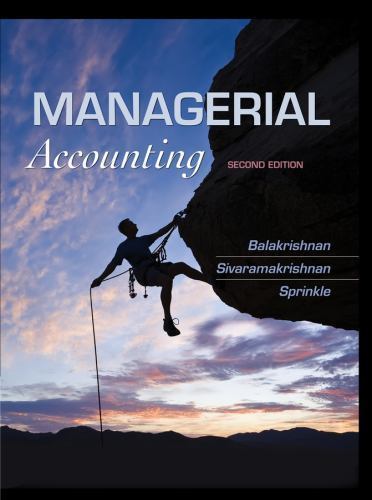Picture 1 of 1

Stock photo

Picture 1 of 1

Stock photo

Managerial Accounting by Ramji Balakrishnan, Geoff Sprinkle and Konduru Sivaramakrishnan (2012, Hardcover)
F
FashionEmoire99 (460)
99% positive feedback
Price:
$23.23
+ $3.99 shipping
Returns:
14 days returns. Buyer pays for return shipping. If you use an eBay shipping label, it will be deducted from your refund amount.
Condition:
Sku: 54010POZZZ. Condition: New. Qty Available: 1.
Oops! Looks like we're having trouble connecting to our server.
Refresh your browser window to try again.
About this product
Product Identifiers
PublisherWiley & Sons, Incorporated, John
ISBN-101118385381
ISBN-139781118385388
eBay Product ID (ePID)143546955
Product Key Features
Number of Pages720 Pages
LanguageEnglish
Publication NameManagerial Accounting
Publication Year2012
SubjectAccounting / Managerial
TypeTextbook
AuthorRamji Balakrishnan, Geoff Sprinkle, Konduru Sivaramakrishnan
Subject AreaBusiness & Economics
FormatHardcover
Dimensions
Item Height1.2 in
Item Weight58.5 Oz
Item Length11 in
Item Width8.3 in
Additional Product Features
Edition Number2
Intended AudienceCollege Audience
Dewey Edition22
Dewey Decimal658.15/11
Table Of ContentMODULE I: INTRODUCTION AND FRAMEWORK CHAPTER 1: ACCOUNTING: INFORMATION FOR DECISION MAKING CHAPTER 2: IDENTIFYING AND ESTIMATING COSTS AND BENEFITS CHAPTER 3: COST FLOWS AND COST TERMINOLOGY MODULE II: SHORT-TERM PLANNING AND CONTROL: MAXIMIZING CONTRIBUTION CHAPTER 4: TECHNIQUES FOR ESTIMATING FIXED AND VARIABLE COSTS CHAPTER 5: COST-VOLUME-PROFIT ANALYSIS CHAPTER 6: DECISION MAKING IN THE SHORT TERM CHAPTER 7: OPERATING BUDGETS: BRIDGING PLANNING AND CONTROL CHAPTER 8: BUDGETARY CONTROL AND VARIANCE ANALYSIS MODULE III: LONG-TERM PLANNING AND CONTROL: MAXIMIZING PROFIT CHAPTER 9: COST ALLOCATIONS CHAPTER 10: ACTIVITY-BASED COSTING & MANAGEMENT CHAPTER 11: CAPITAL BUDGETING CHAPTER 12: PERFORMANCE EVALUATION IN DECENTRALIZED ORGANIZATIONS CHAPTER 13: STRATEGIC PLANNING AND CONTROL MODULE IV: COST ACCOUNTING SYSTEMS CHAPTER 14: JOB-COSTING SYSTEMS CHAPTER 15: PROCESS-COSTING SYSTEMS CHAPTER 16: REFINING SYSTEMS: SUPPORT ACTIVITY AND DUAL-RATE ALLOCATIONS
SynopsisBalakrishnan's Managerial Accounting 2nd edition presents accounting information in the context of a unifying problem-solving framework that shows students the why behind the what and how. Through the framework, students begin to understand the principles driving business practices and learn to adapt to changing business circumstances. Throughout this text students learn to systematically measure costs and benefits to make effective decisions. By linking business decisions with accounting information students will be motivated to learn and make more informed decisions. Accompanied by WileyPLUS, astudent-centered learning and assessment online environment, where students complete automatically graded homework, get feedback on their answers, and access learning materials like the eText at the point of learning. Students come to class prepared because the program is a designed to meet the needs of today's accounting. WileyPLUS sold separately from text., Balakrishnan's Managerial Accounting 2nd edition presents accounting information in the context of a unifying problem-solving framework that shows students the why behind the what and how. Through the framework, students begin to understand the principles driving business practices and learn to adapt to changing business circumstances. Throughout this text students learn to systematically measure costs and benefits to make effective decisions. By linking business decisions with accounting information students will be motivated to learn and make more informed decisions., Balakrishnans Managerial Accounting 2nd edition presents accounting information in the context of a unifying problem-solving framework that shows students the why behind the what and how.
All listings for this product
Be the first to write a review
































